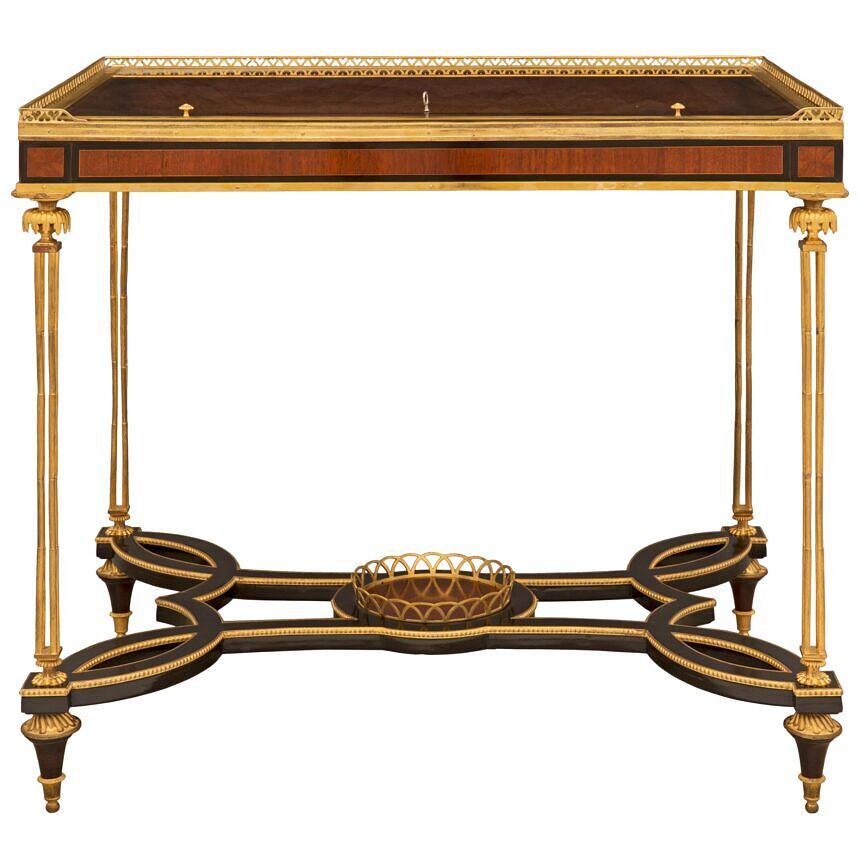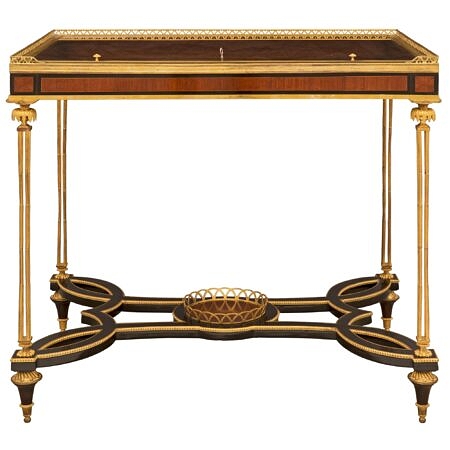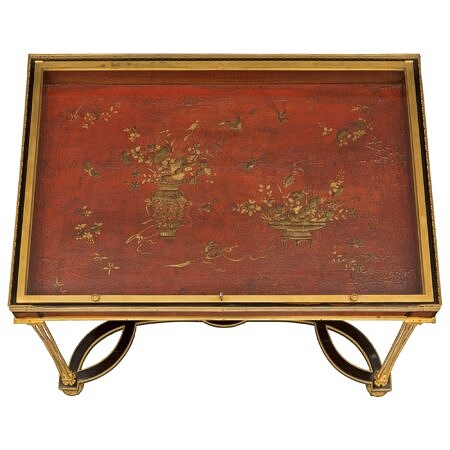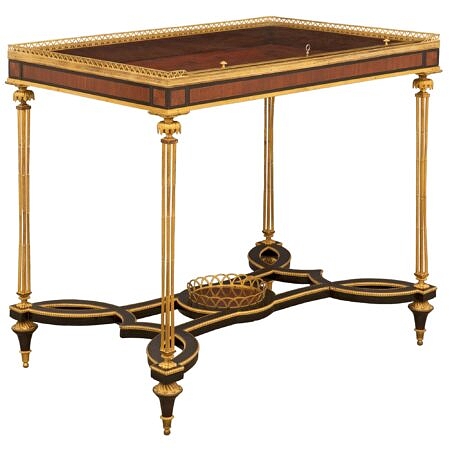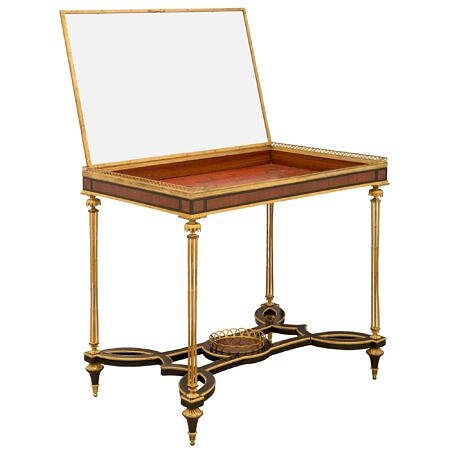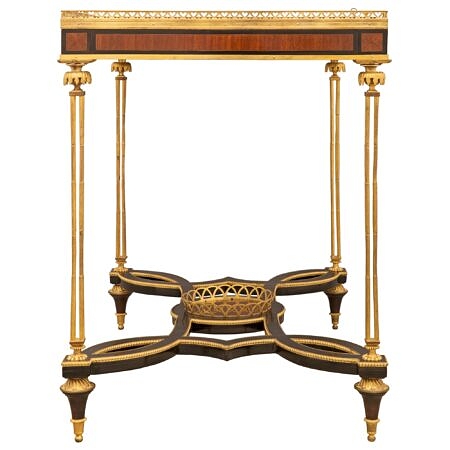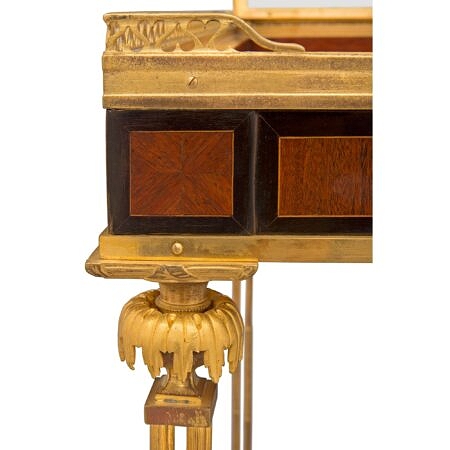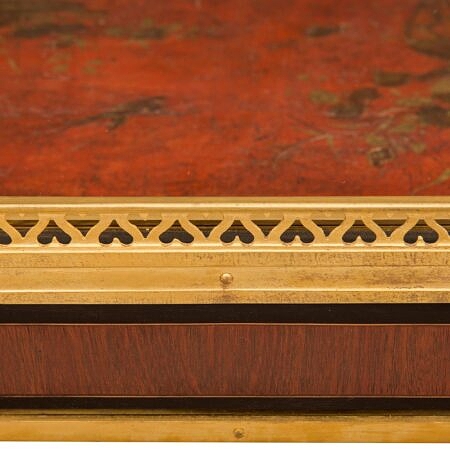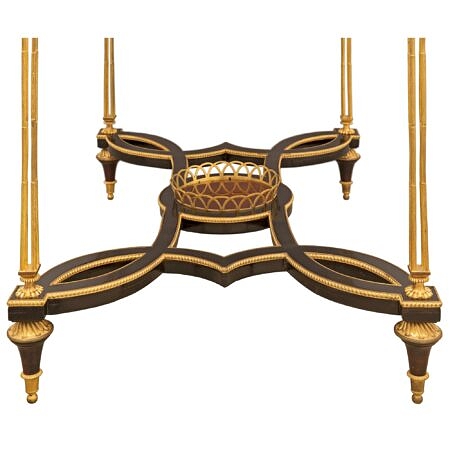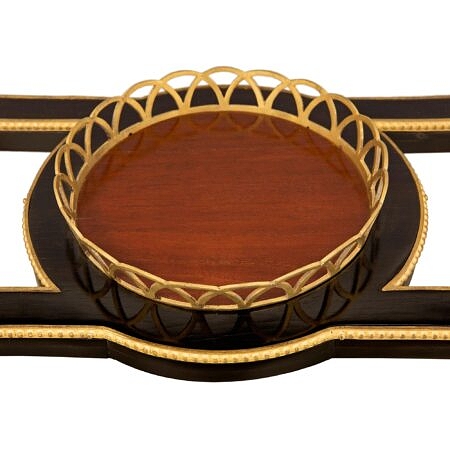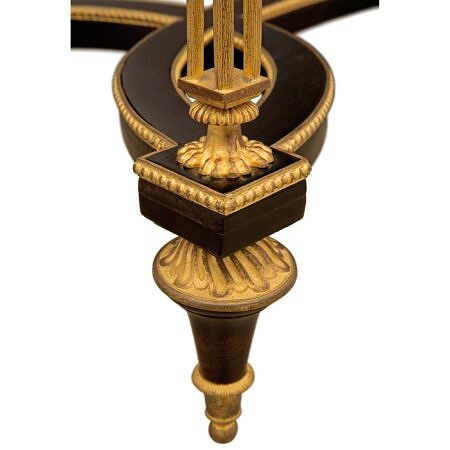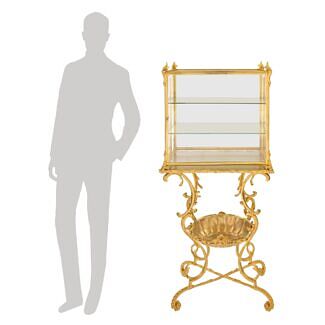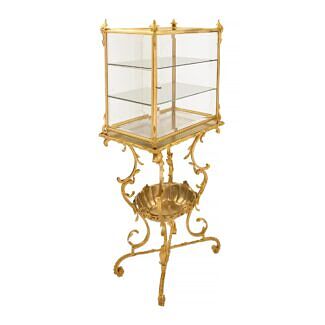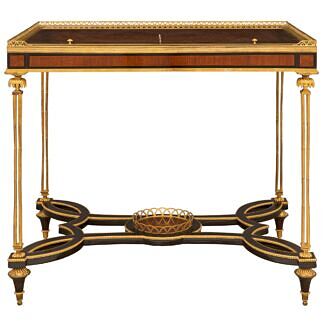A French mid 19th century Louis XVI st. Ebony, Kingwood, ormolu, and Japanese lacquer display table, attributed to Henry Dasson
A spectacular and extremely high quality French mid 19th century Louis XVI st. Ebony, Kingwood, ormolu, and Japanese lacquer display table, after a model by Adam Weisweiler and attributed to Henry Dasson. The table is raised by most elegant topie... — Read More
A spectacular and extremely high quality French mid 19th century Louis XVI st. Ebony, Kingwood, ormolu, and Japanese lacquer display table, after a model by Adam Weisweiler and attributed to Henry Dasson. The table is raised by most elegant topie shaped feet with fine ormolu sabots and spiral fluted top caps. Each leg displays four ormolu supports with a superb and rare bamboo design leading up to a lovely swaging foliate top cap. Each leg is connected by a striking pierced stretcher with most decorative scrolled geometric movements, beaded ormolu bands, and an exquisite central reserve with a mahogany base and delicate pierced basket like design. The straight frieze displays an elegant wrap around ormolu band below beautiful fitted Kingwood bands framed within an Ebony border. Above is the display case with a top door retaining its original glass pane and two foliate finials. The top lifts open to reveal the stunning and wonderfully executed 18th century Japanese lacquer plaque inside. The plaque displays a charming and finely detailed vase and plate with blooming flowers amidst butterflies and birds. The top is framed within an exceptional pierced wrap around ormolu gallery with graceful alternating heart shaped designs. All original gilt and patina throughout. — Read Less
- Item # 5212
-
H: 31 in L: 34.75 in D: 23.5 in
H: 79 cm L: 88 cm D: 60 cm
- France
- 19th Century
- Ebony, Japanese Lacquer, Kingwood, Ormolu
-
Louis XVI st. Read More
(Louis XVI st.) -
Also known as Louis Seize, Louis XVI's style is a style of architecture, furniture, decoration, and art created during Louis XVI’s 19-year reign in France, just before the French Revolution.
Thought to be a reaction and juxtaposition to the prior more elaborate styles, Louis XVI style developed at the end of the Baroque Period and continued until the birth of French Neoclassicism.
King Louis XVI showed little enthusiasm for the old world styles of the Baroque Period and he sought out a create a new “beau ideal” that focused on the purity and grandeur of Ancient Romans and Greeks.
Inspired by Ancient Roman architecture and art, distinct features of the Louis XVI style are linear lines, small repeated motifs, floral medallions hanging from ribbons, acanthus leaves, urns, dolphins, ram, and lion heads, and griffins.
Greco-Roman elements, often used in earlier and later French styles, were also quick common and included fluted and twisted columns, Caryathids, and corbels.
- Henry Dasson Read More
, Adam Weisweiler Read More
Henry Dasson (1825–1896) was a renowned 19th century Parisian maker of gilt-bronze mounted furniture. Unlike other cabinetmakers of the time Dasson began his career as a bronze sculptor, and consequently one characteristic of his work is the quality of his bronze and more precisely of the chasing. Dasson specialized in the production of Louis XIV, XV and XVI style furniture using the finest gilt-bronze mounts, and was recognized as a brilliant ‘ébéniste and bronzier’. He participated in the 1878 Paris Exposition Universelle and exhibited a number of pieces in the Louis XV and XVI styles, as well as pieces of his own modified 18th century designs. Including a table entirely in gilt-bronze, purchased by Lord Dudley. His copy of the celebrated ‘Bureau du Roi’ sold to Lady Ashburton. His works prompted critic Louis Gonse to comment: “newcomer Henri Dasson is rapidly rising to great heights through the perfection of his high quality creations, we warmly applaud him”
Dasson was made a Chevalier of the Légion d'honneur in 1883 and was awarded the Grand Prix Artistique at the 1889 Paris Exposition Universelle.
Adam Weisweiler (1750 — 1810) was a renowned French master cabinetmaker (ébéniste) in the Louis XVI period, working in Paris.
Weisweiler worked notably for the marchands-merciers, who alone could supply him with the Japanese lacquer panels that, combined with ebony and refined gilt-bronze, characterize some of his finest work. Weisweiler supplied the writing table of steel, lacquer and ebony and gilt-bronze for Marie Antoinette at the château de Saint-Cloud in 1784. Also furniture for the Prince Regent (later George IV) at Carlton House, London.
Weisweiler specialised in small refined pieces, with fine lines, delicate legs with light interlaced stretchers, and gilt-bronze low-relief plaques and mounts, often decorated with panels of Japanese lacquer and Sèvres porcelain plaques, even panels of pietra dura.
Weisweiler weathered the Revolution and in 1810 he was supplying Queen Hortense and collaborating with Pierre-Philippe Thomire. After his retirement, his son Jean Weisweiler continued the workshop until 1844
Payment Plan Option Learn More Choose the payment plan option at checkout and customize this payment option with our team. Payment plans are flexible and items will ship once all payments are received.


